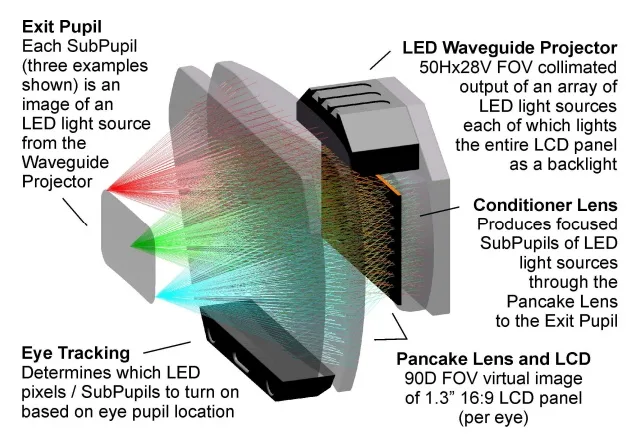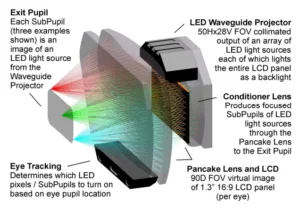Panamorph, best known for their anamorphic cinema lenses, has also been active in virtual reality display technology for decades. Recently, they have developed a new VR headset design using what they call Exit Pupil Modulation (EPM) to deliver improved image quality with lower power consumption while lowering headset cost by using LCD panels. To learn more, we spoke with Panamorph CEO Shawn Kelly.

Chris Chinnock: Before we get into the details, why is Exit Pupil Modulation such an important development for the VR display industry?
Shawn Kelly: Two big reasons: First, EPM means that VR headsets can deliver much higher contrast and clarity with much lower power usage (and cooling requirements) than today’s products. It gets the industry much closer to providing a lightweight headset with image quality similar to a desktop monitor, so people don’t feel such a strong compromise in the imaging experience just to get the benefits of a wearable 3D immersive environment. Second, EPM now allows low-cost LCD technology to outperform OLED and other emissive displays that are far more expensive. So, the one-two punch is that EPM delivers much higher headset performance than OLED but for much lower cost.
Chris Chinnock: How about we start with a basic summary of Exit Pupil Modulation?
Shawn Kelly: EPM replaces the typical LCD backlight of a VR headset with an array of LED light sources at some folded distance behind the LCD panel so that each LED light source fully illuminates the entire LCD panel, but also so that an image of that full LED array forms the optical system exit pupil located at the user’s eye. That means the size and even the shape of the exit pupil can be instantly customized by turning off LED light sources in the array. By turning off an increasing number of LEDs in the periphery of that array, the exit pupil gets smaller. Importantly, once the exit pupil gets smaller than the user’s eye pupil, the contrast, clarity and depth of field of the virtual image dramatically increase while the overall power to light the display dramatically decreases.
Chris Chinnock: Is this basically like stopping down a camera lens for higher clarity and depth of field with a mechanical iris?
Shawn Kelly: It is exactly like that, other than the fact that instead of absorbing unwanted light like a mechanical iris, EPM simply turns off that light outside the iris opening so you get both the performance benefits of a reduced aperture and the reduction of total light entering the magnifying lens.
Chris Chinnock: But isn’t a large exit pupil, in other words a large eye box, an important feature for a VR headset?
Shawn Kelly: The exit pupil needs to be large enough to see the full image, but no larger. The fact is that the spray of light coming out of today’s VR headsets toward the user’s face when using a backlit LCD or emissive display is over ten times the size of the exit pupil needed for the eye to see the full virtual image. All that unnecessary light, especially as it bounces around within a pancake lens, is the direct cause of ghosting and contrast loss in the image and a significant waste of power.
Chris Chinnock: Panamorph was originally looking at eye tracking to make sure a small exit pupil could be steered toward the eye pupil as the user looked around the virtual image. Why is eye tracking not in this current formulation of EPM?
Shawn Kelly: After extensive experimentation using the pancake lens from a Meta Quest Pro headset, we found we can see the entire virtual image with a fixed exit pupil size so small that most of the benefits of EPM are realized without the additional cost and complexity of eye tracking.
Chris Chinnock: Apple and Sony headsets are using OLED in part because of the higher native OLED contrast over LCD despite the higher cost. How does EPM fit in?
Shawn Kelly: Well, the reality is that, by far, the primary reason for low contrast in today’s headsets is all that unnecessary light bouncing around in the lens itself, including light scattered back into the lens from the user’s face. So even though LCD has a lower native contrast compared to OLED, the elimination of all that unwanted stray light with EPM means the net image contrast is actually much higher with LCD than OLED can ever provide.
Chris Chinnock: I presume EPM will not work with OLED panels as you need to separate the image plane from the illumination source?
Shawn Kelly: Correct. The reason EPM works is that the light hitting the display panel is very directional from each light source of the LED array so that an image of that array is formed as an exit pupil, whereas the light from every pixel of an emissive display like OLED is angularly distributed into a very large solid angle, almost all of which doesn’t make it to the user’s eye.
Chris Chinnock: Ok, back to the exit pupil … if a smaller exit pupil is better, why not just make it as small as possible?
Shawn Kelly: Providing a number of user-adjustable exit pupil settings allows personal customization of the viewing environment in a headset with EPM. Some headsets may not provide a perfect fit for every user so a larger exit pupil may be desired to compensate for misalignments. At the other extreme, some users may have a very dialed-in gaming environment where they are more inclined to go with a very small exit pupil even if it partially reduces the intensity of peripheral content (i.e. through vignetting) for the benefits of improved image quality (although some of this can be addressed by non-uniform intensity modulation of the display). There is also the very real challenge of pixel visibility (i.e. screen door effect), which naturally becomes greater as contrast and clarity increase. There may be that ideal setting for each user where the exit pupil is set to reduce clarity somewhat to hide the pixel structure. So, it seems that offering a range of exit pupil settings would support the best user experience in accordance with individual preferences.
Chris Chinnock: How does the EPM design allow for setting different exit pupil sizes?
Shawn Kelly: Providing a number of user-adjustable exit pupil settings (by predetermined on/off arrangements of the LED sources) allows personal customization of the viewing environment in a headset with EPM.
Chris Chinnock: Has EPM been demonstrated? How can someone see it?
Shawn Kelly: Yes, we have active demonstrators in continuous development using a Meta Quest Pro pancake lens. You can see a video of the demo above. For more information including resulting test images, click HERE. We certainly expect that a system optimization of all the components would be best for a production-level product, but the performance improvement is amazing with just an off-the-shelf LED array and a simple flat fold mirror to make the system more compact. The technology can be adopted immediately into new headset designs. We are happy to visit headset manufacturers to demonstrate EPM upon request and to discuss licensing. We have also been invited to demonstrate EPM as a participant in the I-Zone exhibition at the SID Display Week in May.
Chris Chinnock: Will Panamorph be manufacturing its own headset?
Shawn Kelly: Anything is possible, but for now we aim to license the technology to an existing headset manufacturer to bring a new headset with EPM to market faster than we can do by growing an internal capability.
Chris Chinnock: Is EPM a proprietary technology?
Shawn Kelly: Yes, we have multiple comprehensive patents in the US and additional pending patents in the U.S., China, and Japan.
Chris Chinnock: Thanks Shawn. For more information, check out the white paper on my site as well.

After an early career in the aerospace industry, Chris started writing for trade journals in 1993. In 1998, he founded Insight Media where he continues to focus on the latest cutting edge display technologies and their related applications and ecosystems. He grew the company to offer newsletters and market reports, specialized conferences and consulting services with the focus always changing over the years. Currently, Chris supports clients with writing, advising and promotional services. He holds a BSEE from the University of Colorado.

